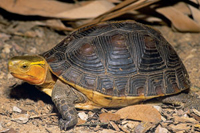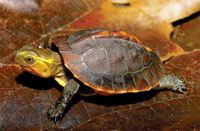The yellow-margined box turtle makes a hardy pet.
I looked out into a turtle pen from my kitchen window a few days ago and happily noted that one of my female yellow-margined box turtles was nesting. Because these semitropical turtles had emerged from their winter dormancy several weeks prior, I've witnessed breeding activity on an almost daily basis. This happens each year as the Florida weather warms and the barometric pressure fluctuates with the advent of seasonal showers. But witnessing breeding behavior and observing nesting behavior are two very different things. Females are very shy when nesting and seem instinctively to lay either when I'm not around or amidst the denser vegetation where they can't be easily seen.
Yellow-margined Box Turtle Breeding
Yellow-margined box turtles (often referred to as) make a woefully inadequate nest for their one to three thin-shelled eggs. Females – my females at least – work diligently to dig a 1 1/2-inch-deep chamber into which their complement of eggs barely fit, even when the eggs lie lengthwise. Once the egg-laden nest is covered again by the female, there may be a slight hump but little other indication of nesting. Believe me, that hump is hard to find in a pen that measures 25 feet by 25 feet and is filled with natural grasses and shrubs. In fact, I more often find the hatchlings than the eggs. Natural incubation takes 60 to 90 days at my latitude (northern Florida). The hatchlings are often found prowling animatedly through the dewy grass or in one of the shallow water receptacles in the pen. Natural Notes The babies of this turtle species are subtly beautiful (have you ever seen a hatchling of any turtle species that you didn't think was exquisite?), but then the adults aren't bad, either! Following the first nesting, a second may occur a week or two later, and the entire sequence may reoccur after a lapse of about a month. The yellow-margined box turtle is indigenous to southern China and the Ryukyu Islands, where they are associated with rice paddies, ponds, and the wooded and brushy surroundings of these habitats. Although it is said that the turtle swims well, mine seldom enter water deeper than where they can easily wade and are most often seen sitting quietly among the tall grasses of their enclosure.
Despite being separated by a half a world from American box turtles, yellow-margined box turtles are remarkably similar to these familiar turtles in configuration and habits.
Yellow-Margined Bio The yellow-margined box turtle (Cuora, formerly Cistoclemmys, flavomarginata) is usually considered monotypic (no subspecies), but occasionally up to three subspecies – sinensis from the Chinese mainland, flavomarginata from Taiwan and evelynae from the Ryukyus – are recognized. Females, the larger and more robust of the sexes, attain a length of 6 3/4 inches. Hatchlings are about 1 1/2 inches long.
 This is a young adult yellow-margined box turtle. These animals are native to southern China, Taiwan and the Ryukyu Islands. |
Field characteristics: This Asian box turtle has a highly domed, somewhat elongate carapace and a strongly hinged plastron. The carapace is dark brown, and most specimens bear a yellow vertebral stripe or spot on each vertebral scute. The growth rings (annuli) are usually quite distinct and the central areolae may be yellowish (the carapace of the young turtles is actually quite rough). The plastron is black rimmed with yellow. The head is grayish on top, and the face is pinkish tan to peach. A broad butter-yellow to bright greenish yellow stripe extends from each eye to the neck. Captive Care Yellow-margined box turtles are diurnal and breed in the spring, usually either before the dew is off the grass or during passing thundershowers when barometric pressure is variable.
The pen in which mine are housed is naturally sloped, and during storms the wooden walls often cause rain puddles that are several inches deep to form at the lower end. These turtles are quick to find these temporary waterholes and will wade out until just the top of their carapace is visible. These puddles also cause earthworms to surface, and this is a favored food of the box turtles. The worms are hunted both in the water and at the edge. These turtles are very alert, and even after many years of captivity they will return quickly to the dry ground and seek shelter beneath overhanging grasses and other ground cover if disturbed. At the advent of cold weather or during periods of drought, they burrow deeply enough to completely conceal themselves.
Once burrowed in, they usually fail to respond to gentle lawn sprinklings or a brief shower, but will emerge and forage if the ground becomes saturated. Although they are not inexpensive, the yellow-margined box turtle remains readily available in the pet trade. Hatchlings are usually advertised at about $125 each, and on the rare occasions that adults are offered they usually cost just a bit more. This is another turtle species that is most readily found in the classified sections of magazines, on classified websites and at herp expos. They are not as commonly offered by pet stores. Although acclimated adult yellow-margined box turtles are quite hardy and well able to tolerate many vagaries of climate as well as food types, the hatchlings are considerably more delicate, will desiccate rapidly and need a bit more care. I have found it best to bring babies indoors where they can be raised under controlled conditions.
The most suitable enclosures for the babies are well-illuminated plastic sweaterboxes or a 10-gallon aquarium containing about a half inch of water (remove chlorines and chloramines before using) and an easily accessed sphagnum moss island. A temperature of about 85 degrees Fahrenheit is ideal. Hatchlings will usually very readily accept black worms and chopped earthworms placed in the water. Prepared foods such as trout chows should be offered at each feeding, but it may take the little turtles some time before they begin accepting these. The home aquarium can be kept cleaner longer by feeding the babies in a small, easily cleaned, outside receptacle containing shallow water.
 Baby yellow-margined box turtlesare more dramatically marked and colored than the adults. |
Adult yellow-margined box turtles are active creatures. Although I realize that not everyone can provide a large outside pen for their turtles, I do urge you to provide the largest pen possible with 2 feet by 4 feet the minimum size for a pair of adults. Larger caging is better, but is also heavier. If you intend to move a pen of this size, it is best to build heavy-duty casters into the original design.
By doing so, you will be able to move the cage indoors or outdoors as the weather conditions dictate. As mentioned earlier, these beautiful box turtles eagerly accept worms and insects, but will also eat an occasional prekilled pinky mouse, trout chow, puppy chow, some berries, other fruits, squash and a little dark lettuce. They will eat both in and out of the water. As with all turtles and tortoises, if you intend to keep this species, it is better to acquire well-acclimated or captive-bred specimens. If you choose to purchase babies, be prepared to offer them the conditions outlined previously. Given suitable caging and diet, a life span of 15 or more years may be reasonably expected with yellow-margined box turtles.


